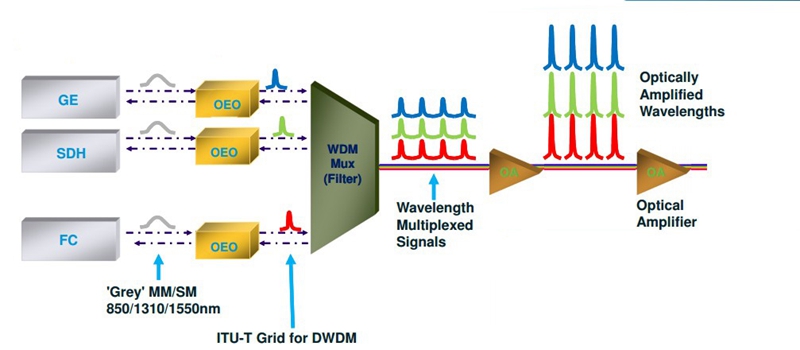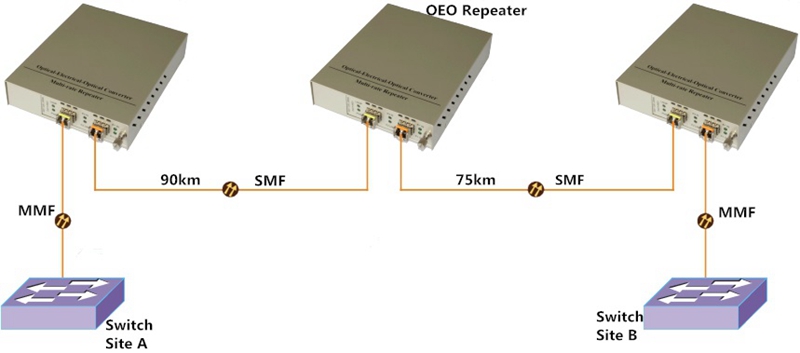May 06, 2017
Nowadays, more and more data centers utilize the WDM technology to gain bigger capacity for various applications, such as, 10G LAN, SONET/SDH, Fiber Channel, etc. Through this method, we can not only reduce the multiple fiber use, carry the signals through only one fiber, but also expand our network capacity. Since there are such benefits from WDM technology, why not use it to deploy our network? At present, there are various kinds of equipment required for WDM system, for instance, WDM Mux Demux, optical fiber amplifier and optical transponder. To build a high performance WDM network, this paper will mainly introduce the optical transponder, an important component in the WDM network, and illustrate why we need optical transponder.
What’s Optical Transponder (O-E-O)?Optical transponder is an optical component designed for amplifying and shaping signals, and even for converting the wavelength and the pattern of the signals, which is commonly used in optical transmission. It can be also reffered to as WDM converter, OEO converter or WDM transponder. With the use of optical transponder, the optical transmission distance can be much extended and the cost for deploying long transmission can be highly reduced. It is really an cost effective solution for long transmission. Furthermore, it features small and handy shape which is very easy to install. To better know the optical transponder, here offers a kind of 10G transponder that enables SFP+ to XFP, SFP+ to SFP+ or XFP to XFP fiber connections.
Why Do We Need Optical Transponder (O-E-O)?The optical transponder can be applied in various occasions for different aims. For instance, it can be regarded as optical repeater, signal wavelength converter, transmission mode converter, etc, for optimizing the signal quality, extending the transmission distance, converting the signal wavelength and the transmission mode. Let’s study these common functions of the optical transponder.
Optical Repeater: the optical transponder can act as an optical repeater to amplify the signals, so that transmission distance can be extended. Meanwhile, it can also dejitters and retransmits the degraded signal for optimizing the signal quality. Hence, a smoother, longer transmission can be achieved.
Signal Wavelength Converter: the optical transponder is always used as signal wavelength converter. It can convert an original kind of signals into several kinds with different wavelengths, hence the WDM network connection can be built on the base of a traditional network connection. When the signals pass through the optical transponder, they can be received, converted and transmitted with other kinds of wavelengths. But the signal content will not be changed in the process. To illustrate how the optical transponder works as signal wavelength converter, the following figure shows the signal wavelength conversion from traditional 850 nm, 1310 nm and 1550 nm into DWDM wavelengths in 10G LAN, SONET/SDH, Fiber Channel applications for your reference.
Transmission Mode Converter: we can also use the optical transponder to change the fiber transmission mode, such as, converting multimode into singlemode transmission and duplex into simplex transmission. Here offers a multimode into singlemode convertion design as an example. From the figure, you can learn that the signal is firstly transmitted through multimode fiber. And after passing through the first optical transponder, it can be transmitted through singlemode fiber at lengths 90 km. To extend the transmission distance, the second optical transponder is deployed and the transmission is extended from 90 km to 165 km. Finally, the signal will pass through the third optical transponder and the transmission mode will be converted into multimode again. Thereby a long singlemode transmission up to 165 km can fit with the existing multimode system.
ConclusionIt can’t be denied that the optical transponder plays an important role in our network. It can not only highly extend the transmission distance, but also increase the network capacity by converting the traditional signals into CWDM or DWDM signals to fit with the WDM system. What’s more, it can also change the fiber transmission mode. Except for these common functions, there are still several functions not mentioned, for instance, offering a redundant fiber path for extra protection. Then, why not use the optical transponder to optimize our network?
Posted by: katherinewangfs at
03:47 AM
| Comments (5)
| Add Comment
Post contains 691 words, total size 6 kb.
Posted by: Door Repair Vienna VA at June 16, 2021 11:50 AM (49dSr)
Posted by: max watson at July 01, 2021 06:41 AM (OQWo5)
Posted by: peter John at July 06, 2021 07:23 AM (uvOvW)
Posted by: jhon alex at July 09, 2021 11:20 AM (qIK2L)
Posted by: Thomas at October 13, 2023 06:29 AM (qKEkm)
37 queries taking 0.0651 seconds, 71 records returned.
Powered by Minx 1.1.6c-pink.












